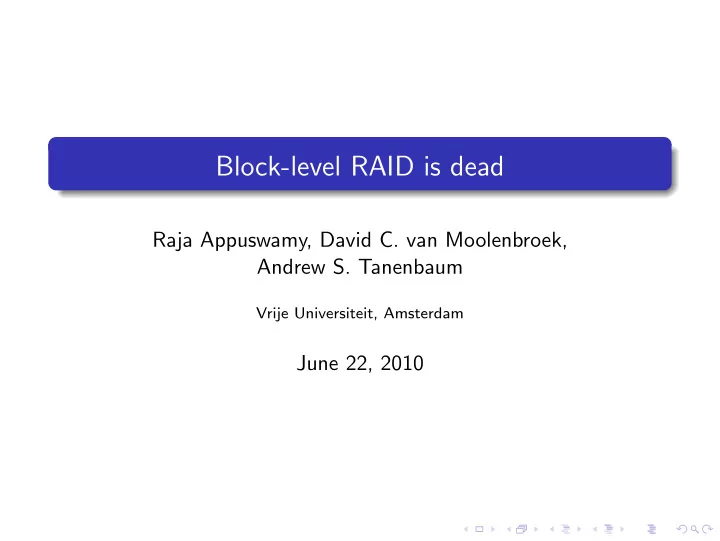

Block-level RAID is dead Raja Appuswamy, David C. van Moolenbroek, Andrew S. Tanenbaum Vrije Universiteit, Amsterdam June 22, 2010
Traditional storage stack File Originally one file system per disk system Later RAID layer was introduced Block-level RAID and Volume managers SW RAID Storage stack has remained the same for decades Disk Compatibility-driven integration has fatal flaws driver
Problem 1: Silent data corruption Disks exhibit fail-partial failure modes Lost, torn, misdirected writes Such failures result in silent data corruption Checksumming algorithms fail to detect corruption Most algorithms detect only a subset of all failure modes Parental checksumming detects all classes of failures Parental checksumming fails with block-level RAID RAID-initiated reads are unverified RAID-initiated reads propagate corruption
Problem 2: Heterogeneity issues Integration of new devices is an interesting problem Building device-specific FS Not compatible with block-based RAID Building a translation layer Widens the “Information gap” Duplication of functionality
Problem 3: Device failure Traditional RAID fails ungracefully Graceful degradation has two requirements Selective metadata replication Fault-isolated file placement Semantically unaware traditional RAID cannot fail gracefully
Problem 4: Administration nightmare Too many Volume management abstractions PVs, VGs, LVs, FSes, etc. Simple tasks need several error-prone steps Too many tunable parameters Chunk size, stripe width, LV size, etc. Improper configuration leads to bad performance Coarse-grained policy specification Need more flexibility (per file, directory or volume)
Problem 5: System failure Crashes/power failures result in “Write holes” HW RAID uses NVRAM to sidestep this issue Software RAID cannot rely on NVRAM Whole-disk resynchronization is impractical Journaling duplicates functionality and affects performance
Loris - the new storage stack File-based interface between layers Each file has a unique file identifier Each file has a set of attributes File-oriented requests: create truncate delete getattr read setattr write sync
Modular split and reliable flip (1) File system SW RAID Disk driver
Modular split and reliable flip (2) File system SW RAID Disk driver
Loris - the new storage stack POSIX call processing Directory handling Data caching RAID-like file multiplexing Logical policy storage Metadata caching Parental checksums On-disk layout
Solution to problem 1: End-to-end data integrity Physical layer converts fail-partial to fail-stop failures Physical layer verifies all requests alike RAID algorithms provide recovery from fail-stop failures
Solution to problem 2: Embracing heterogeneity Device-specific physical layers Can exploit device access characteristics Eliminate multiple translation steps RAID and Volume management across device families File abstraction hides device-specific vagaries No need to reimplement RAID algorithms per device family
Solution to problem 3: Graceful failure Directories replicated on all devices Naming layer chooses RAID 1 policy Zero-effort fault-isolated placement DIRECTORY FILE DIRECTORY FILE DIRECTORY FILE FILE 1 FILE 2 FILE 1 FILE 3 FILE 2 FILE 3
Solution to problem 3: Graceful failure Directories replicated on all devices Naming layer chooses RAID 1 policy Zero-effort fault-isolated placement DIRECTORY FILE DIRECTORY FILE DIRECTORY FILE FILE 1 FILE 2 FILE 1 FILE 3 FILE 2 FILE 3
Solution to problem 3: Graceful failure Directories replicated on all devices Naming layer chooses RAID 1 policy Zero-effort fault-isolated placement DIRECTORY FILE DIRECTORY FILE DIRECTORY FILE FILE 1 FILE 2 FILE 1 FILE 3 FILE 2 FILE 3 66% availability under two failures!
Solution to problem 4: Simplified administration File pools similar to storage pools New device ⇒ new source of files Completely automate error-prone tasks “File systems/Volumes” share the file pool Flexible policy assignment Logical layer provides mechanism Any layer can assign policies Policies per file, directory, or volume
Solution to problem 5: Crash recovery Traditional FS recovery techniques can be used Journaling in physical layer (ext3) Transactional COW (ZFS) Goal is to protect important user data Metadata journaling does not help Full data journaling is very expensive Can we do selective data journaling?
Conclusion We examined block-level RAID along several dimensions We highlighted several fatal flaws We suggested a simple, yet fundamental change to the stack We showed how the new stack solves all issues by design
Recommend
More recommend